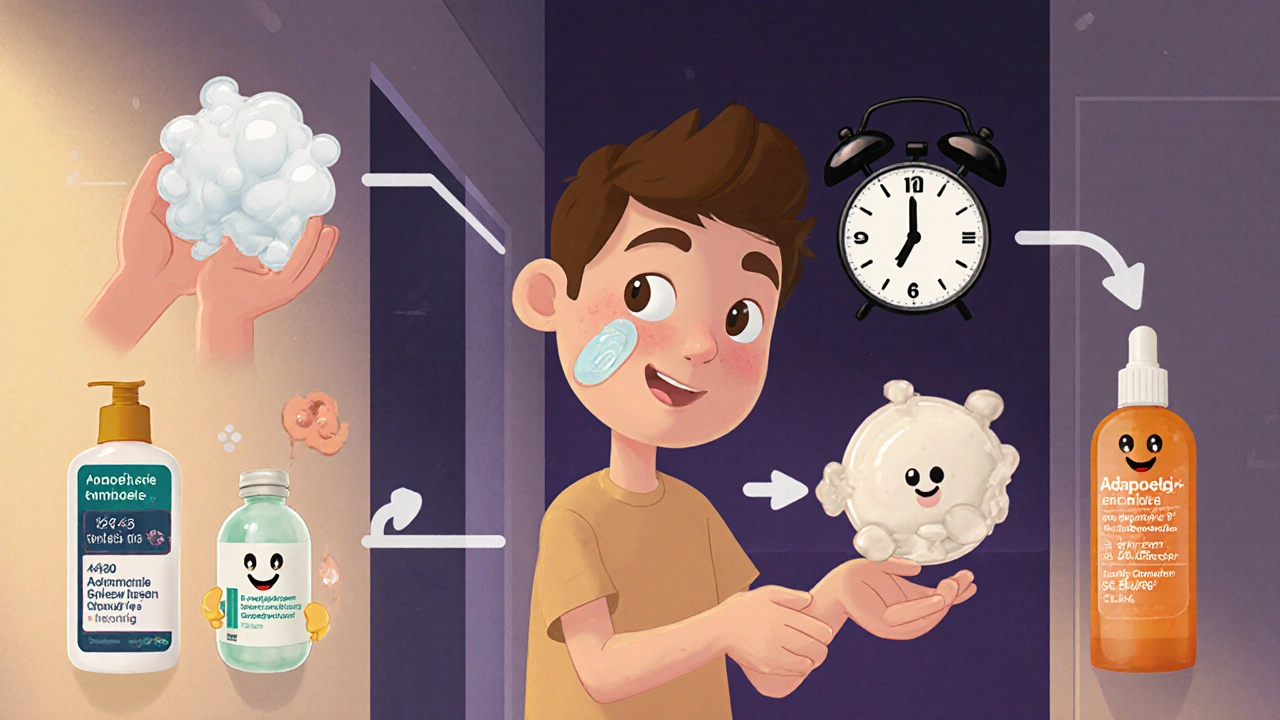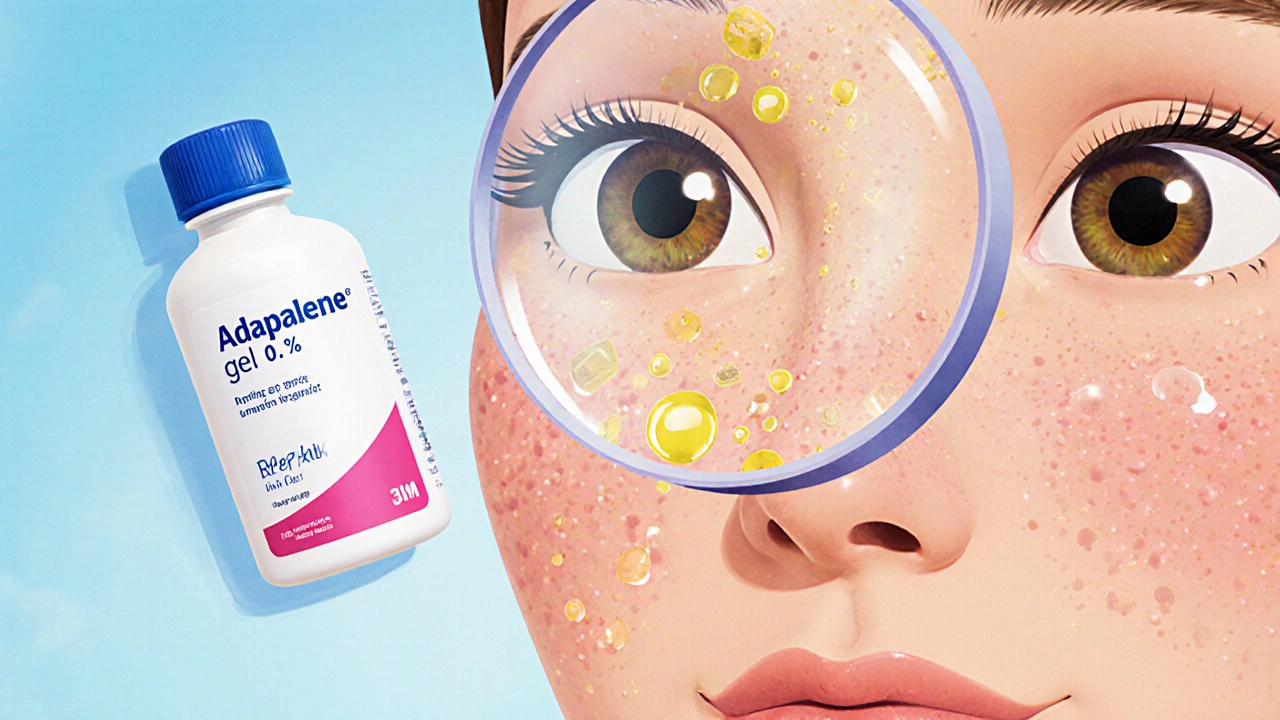Ever wondered why your skin stays greasy all day even after a rigorous cleanse? The culprit is usually excess sebum - the natural oil produced by the skin’s sebaceous glands. When that oil mixes with dead skin cells, it creates the perfect breeding ground for acne. Enter Adapalenea third‑generation synthetic retinoid that targets clogged pores and inflammation. Paired with oily skin, it can be a game‑changer.
Key Takeaways
- Adapalene regulates cell turnover, keeping pores clear without over‑drying oily skin.
- Start with a low concentration (0.1% or 0.3%) and apply every other night.
- Combine with a gentle, non‑comedogenic cleanser and oil‑free moisturizer.
- Sun protection is non‑negotiable - adapalene can increase photosensitivity.
- Most users see visible improvement in 4‑6weeks; results keep getting better up to 12weeks.
What Exactly Is Adapalene?
Adapalene belongs to the retinoidclass of vitaminA derivatives that influence skin cell growth. Unlike older retinoids such as tretinoin, it is chemically stable in light and air, which means the formula stays effective in a regular moisturizer or gel. The FDA approved the 0.1% gel in 1996 for acne, and a stronger 0.3% version followed in 2015 for tougher breakouts.
Why Oily Skin Gets a Special Mention
Oily skin isn’t just shiny - it produces more adapalene oily skin than any other type. Higher sebum output means pores fill faster, and traditional acne treatments that dry out the skin can backfire, prompting the glands to work even harder. The ideal solution therefore needs to clear pores *and* keep the surface barrier intact. Adapalene’s moderate irritation profile makes it suitable for this balancing act.
How Adapalene Works on Oily Skin
- Normalises keratinisation: It speeds up the shedding of dead cells, preventing them from sticking together and forming comedones.
- Reduces inflammation: By modulating inflammatory pathways, it calms the red, swollen bumps that oily skin often displays.
- Minimises sebum‑related clogging: Although it doesn’t block oil production, clearer pores mean oil can flow out rather than sit trapped.
Clinical trials cited by the Dermatologistmedical specialists who treat skin disorders show a 60‑70% reduction in inflammatory lesions after 12weeks of consistent use, even in patients with high sebum levels.

Step‑by‑Step Routine for Oily‑Skin Users
- Cleanse: Use a gentle, sulfate‑free foaming cleanser that says “oil‑free” or “non‑comedogenic.” Rinse with lukewarm water and pat dry.
- Wait 20‑30minutes: This allows the skin’s natural pH to rebalance, reducing potential irritation.
- Apply adapalene: Take a pea‑size amount and smooth it over the entire face, avoiding the eye area. If you’re new, start every other night.
- Moisturise: Choose a lightweight, oil‑free gel‑cream that contains hyaluronic acid or niacinamide. This step restores the barrier without adding shine.
- Sun protection: Finish with a broad‑spectrum SPF30+ gel. Reapply every 2hours when outdoors.
Consistency beats intensity - the skin adjusts better to a steady regimen than a once‑a‑week “miracle” dose.
Choosing the Right Concentration
| Strength | Typical Use | Ideal For | Potential Side‑Effects |
|---|---|---|---|
| 0.1% | Every other night for 2-4weeks, then nightly | Beginners, sensitive oily skin | Minor redness, mild peeling |
| 0.3% | Nightly from day1 (if skin tolerates) | Experienced users, moderate to severe acne | Increased dryness, occasional stinging |
If you notice persistent irritation, step back to a lower frequency for a week before resuming.
Combining Adapalene with Other Acne Actives
Many people wonder whether they can layer benzoyl peroxide, salicylic acid or niacinamide with adapalene. The answer is nuanced:
- Benzoyl peroxide: Powerful antibacterial; use it in the morning while reserving adapalene for night to avoid excessive dryness.
- Salicylic acid (a beta‑hydroxy acid): Helps dissolve oil inside pores. A low‑strength serum (0.5%) can be applied after cleansing, but give at least a 15‑minute gap before adapalene.
- Niacinamide: Reduces inflammation and sebum production. It’s safe to mix and can offset redness caused by adapalene.
Avoid using two retinoids (e.g., tretinoin + adapalene) simultaneously - they’ll overwhelm the skin.
Common Mistakes & How to Fix Them
- Skipping moisturizer: Even oily skin needs hydration. A dry barrier triggers more oil.
- Applying too much: A pea‑size amount covers the whole face. More doesn’t mean faster results.
- Neglecting sunscreen: UV exposure can counteract adapalene’s benefits and increase hyper‑pigmentation.
- Using harsh scrubs: Physical exfoliation damages the skin barrier, making adapalene irritation worse.

When to Expect Results
Patience is key. Most users notice a reduction in surface oil and fewer breakouts within the first 2-3weeks. By week4, the skin’s texture begins to smooth out. Full benefits - clearer complexion, faded post‑acne marks, and steadier sebum levels - usually appear around weeks8-12.
Safety Profile & Who Should Avoid It
Adapalene is safe for most adults, but avoid it if you:
- Are pregnant or breastfeeding (consult a doctor first).
- Have severe eczema or rosacea flare‑ups.
- Are using isotretinoin - the combined retinoid load can cause severe irritation.
Always do a 48‑hour patch test on the jawline before committing to daily use.
FAQs
Can I use adapalene on my whole face if I have oily T‑zone only?
Yes. Apply a thin layer over the entire face; the drug will work wherever pores are clogged. If the cheeks stay completely clear, you’ll still benefit from the overall reduction in inflammation.
Do I need a prescription for adapalene?
The 0.1% gel is now available over‑the‑counter in many countries, including South Africa. The 0.3% strength usually requires a pharmacist’s recommendation.
Will adapalene make my skin oily again after I stop using it?
When you discontinue use, sebum production returns to its natural level. If you maintain a good cleansing routine, the skin should stay clearer than before you started.
Is adapalene safe for teenagers with oily skin?
Yes. Dermatologists often recommend the 0.1% formula for teens because it’s effective yet gentle compared to older retinoids.
Can I combine adapalene with vitaminC serum?
VitaminC is best applied in the morning because it’s an antioxidant. Use adapalene at night to avoid cross‑irritation.
How long should I stay on adapalene?
Most dermatologists suggest a minimum of three months to assess true efficacy. If the skin remains clear, you can continue long‑term with a maintenance routine.
Will adapalene help with blackheads?
Yes. By normalising cell turnover, it prevents the clogs that become blackheads, especially on the oily nose area.
Is it okay to use a physical exfoliator while on adapalene?
Limit physical scrubs to once a week at most, and choose a very gentle formula. Over‑exfoliation can compromise the barrier and increase irritation.
What should I do if I get a flare‑up?
Stop using adapalene for a few days, focus on a soothing moisturizer with ceramides, and re‑introduce the retinoid slowly once the redness subsides.
Bottom Line
For anyone battling the double‑edged sword of excess oil and acne, adapalene offers a balanced, science‑backed route to clearer skin. Its ability to unclog pores without stripping away essential moisture makes it a rare win for oily types. Pair it with a minimalist routine, sunscreen, and patience, and you’ll likely see the shine fade and confidence rise.
